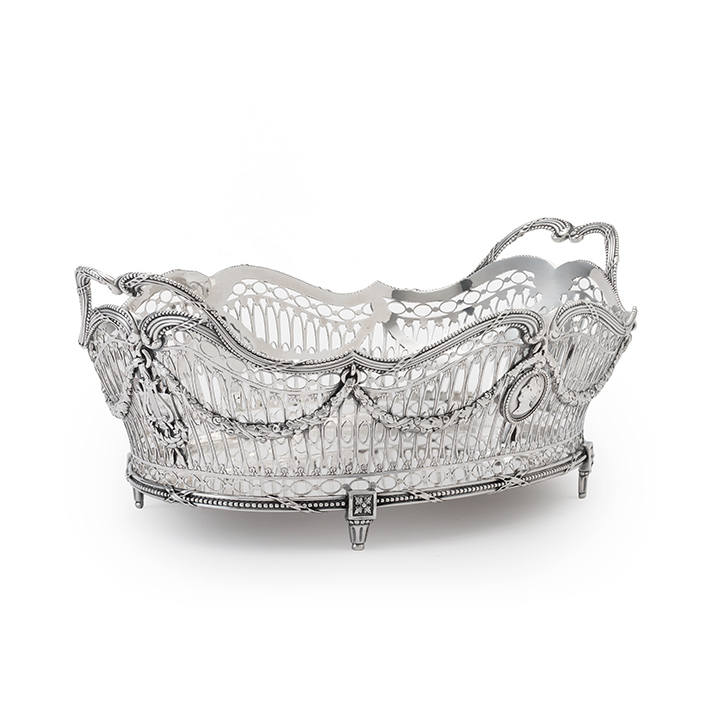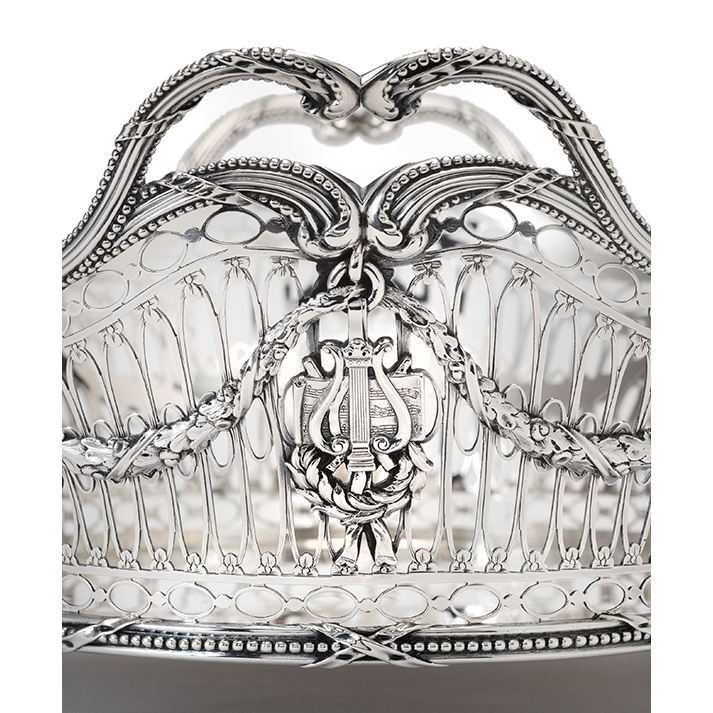
Large silver basket
About This Project
Large silver basket
Reynier Brandt
Amsterdam, 1782
1433 grams; 36,6 cm long; 24,5 cm width; 14,2 cm high
The sides of the large oval silver basket with plain bottom are pierces with elongated ovals. The upper and lower bands , placed between pearl rims, are also pierced with horizontal ovals. The sides are applied with foliate swags, suspending a medallion with a classical bust. On the short sides, under the handles, a lyre-shaped ornament with a sheet of music is applied. The handles on both sides are openwork with leaf ornament and trimmed with pearl rims, merging into the similar curved upper rim. Fully marked at the reverse of the basket and displaying an assay stripe.
In the eighteenth century, large silver baskets were made in Dutch cities such as Amsterdam, The Hague and Rotterdam as utensils, oval in shape, often with pierced sides. The large silver basket was part of luxury tableware in wealthy households. In inventories, this type of basket is often referred to as ‘breadbasket’, although it should be noted that the term ‘bread’ can be taken broadly. After all, all kinds of baked goods can be presented with panache in these richly decorated baskets. However, not only bread, puffs or cake will have been served in it, but also fruits, glazed fruits, and perhaps also nuts.
Style period and style characteristics
When handling the basket and carefully studying it, the first striking thing are its strong stylistic features, which appear to correspond completely with the date of manufacture, 1782, which can be read from the date letter, which is marked on the reverse of the basket. The pearl rims and the elegant decoration of foliate swags are characteristic of the style period in the last quarter of the eighteenth century, in which neoclassicism, often called Louis XVI style, reigned supreme. The eighteenth century had many successive style periods. Eighteenth-century silversmiths liked to follow the new fashion, which mainly blew over from Paris and later also from England to the Low Countries. That is why we still link these style periods to the reigns of the French kings.
The silversmith Reynier Brandt was born in 1707 in Wezel (Germany), as the son of Wilhelm Brandt and Anna Katharina Westerholt. On May 5, 1734 he was registered as a citizen (poorter) of the city of Amsterdam with the description : ‘silversmith and from Wesel’. In 1734 he was admitted as a silversmith in the guild of Amsterdam. A few years later, in 1737, he married Maria van Wierop, who was already the widow of silk stocking maker Hendrik Swiering. For Maria, it was her second marriage. Her son, Reijnier Swiering, became Reynier’s stepson. The couple settled on the Lauriergracht where, according to the note of the marriage, they both already lived. In 1788 the Reformed Reynier Brandt died and was buried on 11 December in the Westerkerk, where his wife Maria was also buried on 11 April 1782.
For more information, click here




